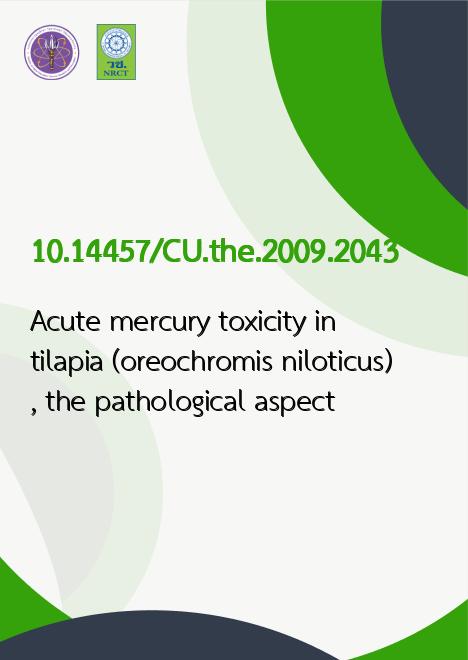
|
Acute mercury toxicity in tilapia (oreochromis niloticus), the pathological aspect |
|---|---|
| รหัสดีโอไอ | |
| Title | Acute mercury toxicity in tilapia (oreochromis niloticus), the pathological aspect |
| Creator | Kasem Rattanapinyopituk |
| Contributor | Anudep Rungsipipat, Aranya Ponpornpisit |
| Publisher | Chulalongkorn University |
| Publication Year | 2552 |
| Keyword | Mercury -- Toxicology, Nile tilapia |
| Abstract | Mercury is one of most toxic heavy metals which can contaminate natural water sources. Humans can be exposed to mercury by consumption of mercury contaminated fish. Therefore, it is most appropriate model to use fish as environmental marker of mercury contamination. The purpose of this study is to investigate acute mercury toxicity in tilapia (Oreochromis niloticus) via histopathological, autometallography, Hg analysis by ICP-AES method and detecting metallothionein protein by immunohistochemistry techniques and metallothionein gene expression. Tilapias were divided into twelve experimental groups and one control group. The experimental groups included intraperitoneally injected with 0.5, 1, 2, 5 µg/g mercuric chloride (HgCl[subscript 2]), oral administration with 0.5, 1, 2, 5 mug/g HgCl[subscript 2] , and 0.5, 1, 2, 5 mug/ml HgCl[subscript 2] semi-static exposure groups. All fish showed the clinical appearance of respiratory failure followed by death in 2 and 5 mug/ml HgCl[subscript 2] semi-exposure groups on first day (day 0) of experiment. The major histopathological lesions includes tubulonephrosis, increasing immature nephrons, and deposit of crystal in trunk kidneys, increasing melanomacrophages centers (MMCs) in spleen, and losing of fat storage, degeneration of hepatocytes, and pancreatic atrophy in hepatopancreas. Following autometallography, silver-enhanced Hg grains were visualized in renal tubular epithelium, MMCs in spleen and in pancreatic acini in accordance with high mercury levels. The amount and location of visualized grains differ from routes and doses of HgCl[subscript 2]. The semi-exposure groups and higer concentration produced more grains than other routes and lower concentration. An expression of metallothionein (MT) protein revealed in renal tubular epithelium, MMCs in spleen, and pancreatic acini of 0.5, and 1 µg/ml semi-static exposure groups after day 9 and 6 respectively. From this present study, it concludes that pathological lesions, autometallography, expression of metallothionein protein by immunohistochemistry can be used to investigate acute mercury toxicity in tilapia. |
| URL Website | cuir.car.chula.ac.th |